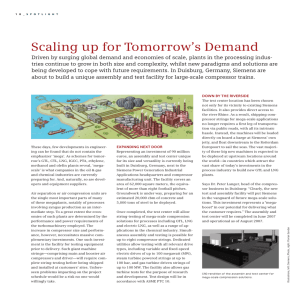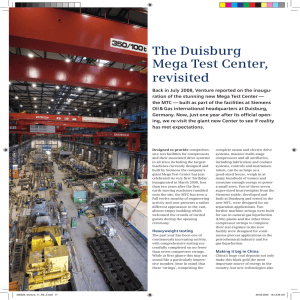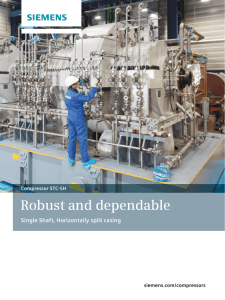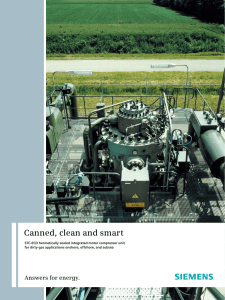A quantum leap in testing
advertisement
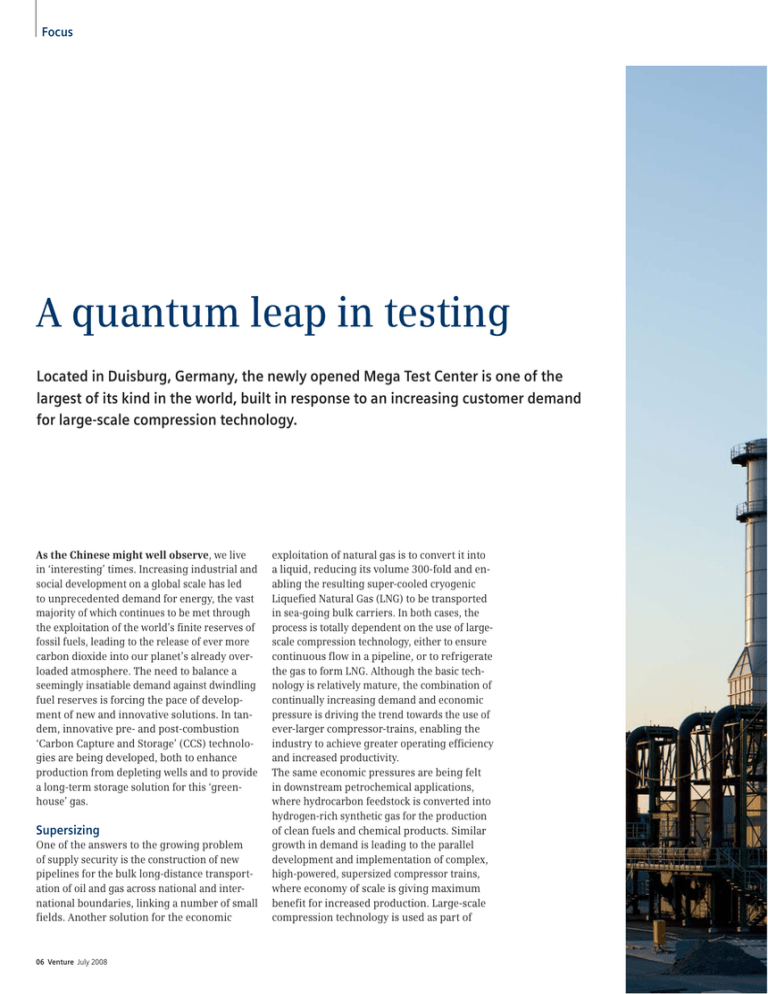
Focus A quantum leap in testing Located in Duisburg, Germany, the newly opened Mega Test Center is one of the largest of its kind in the world, built in response to an increasing customer demand for large-scale compression technology. As the Chinese might well observe, we live in ‘interesting’ times. Increasing industrial and social development on a global scale has led to unprecedented demand for energy, the vast majority of which continues to be met through the exploitation of the world’s finite reserves of fossil fuels, leading to the release of ever more carbon dioxide into our planet’s already overloaded atmosphere. The need to balance a seemingly insatiable demand against dwindling fuel reserves is forcing the pace of development of new and innovative solutions. In tandem, innovative pre- and post-combustion ‘Carbon Capture and Storage’ (CCS) technologies are being developed, both to enhance production from depleting wells and to provide a long-term storage solution for this ‘greenhouse’ gas. Supersizing One of the answers to the growing problem of supply security is the construction of new pipelines for the bulk long-distance transportation of oil and gas across national and international boundaries, linking a number of small fields. Another solution for the economic 06 Venture July 2008 exploitation of natural gas is to convert it into a liquid, reducing its volume 300-fold and enabling the resulting super-cooled cryogenic Liquefied Natural Gas (LNG) to be transported in sea-going bulk carriers. In both cases, the process is totally dependent on the use of largescale compression technology, either to ensure continuous flow in a pipeline, or to refrigerate the gas to form LNG. Although the basic technology is relatively mature, the combination of continually increasing demand and economic pressure is driving the trend towards the use of ever-larger compressor-trains, enabling the industry to achieve greater operating efficiency and increased productivity. The same economic pressures are being felt in downstream petrochemical applications, where hydrocarbon feedstock is converted into hydrogen-rich synthetic gas for the production of clean fuels and chemical products. Similar growth in demand is leading to the parallel development and implementation of complex, high-powered, supersized compressor trains, where economy of scale is giving maximum benefit for increased production. Large-scale compression technology is used as part of Focus Focus Impressions from the inauguration of the Mega Test Center, March 6 and April 18, 2008 08 Venture July 2008 Focus current CCS systems for carbon injection and sequestration, where carbon dioxide released directly from the combustion of natural gas or from the reforming process for the production of hydrogen-rich syngas, is forced at high pressure into fast-depleting or exhausted onshore or subsea reservoirs, providing longterm storage, reducing emissions and enhancing production. Response to market needs As one of the largest and longest-established developers, manufacturers and suppliers of leading-edge compression systems for the energy industries, Siemens has had to remain responsive to the continuously evolving needs of its customers. The demand for ever-larger machines incorporating evermore complex technologies, coupled with increasingly rigorous test programs and performance specifications, shorter delivery schedules and greater manufacturing flexibility, has led to the requirement for a larger, centralized and more comprehensive assembly and test facility. Designed to meet current needs for the full range of machines currently supplied by the Siemens Energy Sector Oil & Gas division, as well as for A 1950’s bird’s eye view of today’s Mega Test Center site, framed by the Rhine and Ruhr rivers. next-generation compressors and associated systems under development, work started in mid-2006 on the construction of a giant new ‘Mega’ Test Center (MTC) adjacent to the manufacturing plant in Duisburg. With a total length of 180 meters, a span of 40 meters and a height of 35 meters, the huge new building, covering an area of more than one and a half full-size football pitches, was completed in less than two years and represented a capital investment of some EUR100 million, the largest single investment ever made by Siemens in Europe. Inside the MTC two high-level traveling gantrycranes each provide a combined lifting capability of up to 700 tons to a height of 25 meters, allowing the assembly and testing of ultralarge compressor trains. No fewer than six of these giant machines, each comprising a gas turbine, steam turbine or electric-motor drive, compressor and ancillary systems can be installed and tested at any one time. The building also includes three intermediate-level cranes each capable of lifting up to 100 tons to 23 meters, with a further six 10-tonne cranes with a lifting height of 19 meters. Far from being a big shed containing some heavy lifting equipment, the MTC incorporates a sophisticated infrastructure and bespoke utilities, purposedesigned to support testing up to full load on the largest and most complex machines. Gas can be supplied to fuel large industrial gas-turbine compressor drives of up to 160 megawatt (MW) at flow rates up to 10 kg/s, with future upgrades to allow almost double this volume for even higher-powered prime movers if required. A state-of-the-art, high-voltage highpower pulse-frequency converter station provides a comprehensive range of outputs for testing the largest electric drive systems at power ratings up to 100 MW. The new facility is also able to test steam turbine-driven compressor strings up to coupling power ratings of 35 MW with steam conditions of 100 bar/500°C and flow rates of 140 tons per hour. High pressure water for machine cooling can be supplied at flow rates up to 7,500 cubic meters per hour, enabling full-load testing of closed-loop compressor strings with coupled drive power ratings up to 100 MW and partial-load opencycle testing of large air compressors. The new building also provides direct rail access to heavy-lift ship-loading facilities at the city’s The same site today, now home of Siemens global Oil & Gas headquarters and the Mega Test Center. A cargo train (front) emphasizing the vast dimensions of the Mega Test Center. Comprehensive facilities July 2008 Venture 09 Focus The inauguration party is over. From August on, this will be the space for testing largest-scale compression technology for the oil-and-gas and processing industries around the globe. nearby docks which form the largest inland port in Europe with onward links to the main sea ports of Rotterdam, Antwerp and Amsterdam, enabling even the largest and heaviest machines and compressor-strings to be shipped to their final destinations around the globe in the shortest time possible. Testing, testing The new Mega Test Center has been designed specifically to assemble and test the large, custom-built systems for tomorrow’s mega-scale plants currently planned or under construction by the oil, gas and petrochemical industries worldwide. A veritable alphabet soup of processes — GTL, CTL, LNG, PTA, IGCC, IRCC, CCS — as well as ethylene, methanol and olefin plants, all demand massive mega-machine trains to provide the highest possible outputs, efficiencies and economies of scale. Responding to industry trends, Siemens now has the ability to carry out full-load testing of both electric motor-driven and gas turbine-powered compressor strings for LNG production plants and part-load testing of gas-to-liquids compressor strings fitted with steam-turbine drive systems. Large compressor-strings for PTA Preparing the test hall for inauguration. Note the three gantry cranes at top. 10 Venture July 2008 production — the basic feedstock for the manufacture of polyester plastics — powered by electric motors, steam turbines or gas expander drives can be routinely assembled and tested in the MTC. Compressors designed for a variety of applications in olefin plants, compressors for large-scale air-separation processes, together with virtually all types and sizes of heavyduty industrial compressors and steam turbines can also be tested in the facility. Methodology employed includes mechanical running tests to American Petroleum Institute Specifications API 617/612 under no load, part-load and full-load conditions and performance tests in accordance with ASME Performance Test Codes PTC 10 Type 1 or 2. These include the facility for compressor testing with inert gases at 40 bar and 250°C in a permanently installed test loop at power ratings up to 100 MW. Alternatively, machines can be tested using air at suction volume flows in excess of one million cubic meters per hour, connected to permanently installed flow-metering lines and blowoff stacks, or with hydrocarbon gases in individually installed closed-loop systems, or indeed with virtually any customer-specified test method. Size is not all White and light — the MTC’s employee quarters. Quaint aesthetics — array of cooling fans for gas turbine exhausts. With the low-hanging fruit all but picked by the oil and gas companies, they are becoming more dependent than ever before on the development of new technologies to provide economic solutions. For Siemens this has meant that its compressors and drive systems have not just grown bigger, they have also grown smarter. Ground-breaking new developments in design, materials and manufacturing technologies have led to the development of totally new concepts in gas compression. One example of this is the ECO-II, a seal-less, emissionsfree, totally enclosed, centrifugal compressor and integrated electric drive already in service at an onshore gas field in the Netherlands (see Venture Issue 7). As Frank Stieler, CEO of Siemens Oil & Gas commented during the opening ceremony at the new Mega Test Center, “The principal driver for the oil and gas industry can be summed up as ‘Easy is over’. The challenge for producers is to supply greater volumes of oil and gas from fewer and smaller reserves, leading to a higher demand for world-class technology.” Clearly, Duisburg’s new MTC will help the company meet the challenge. Focus
